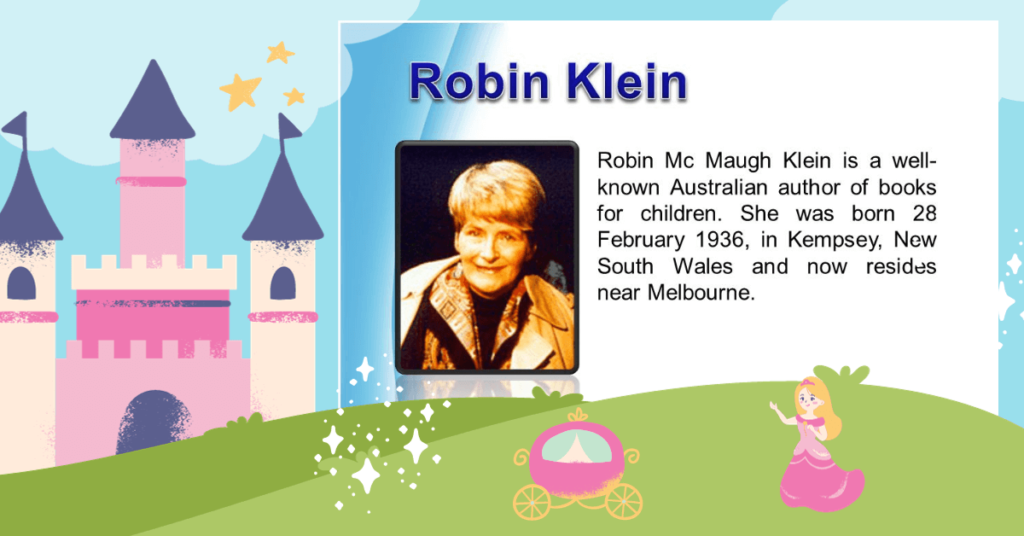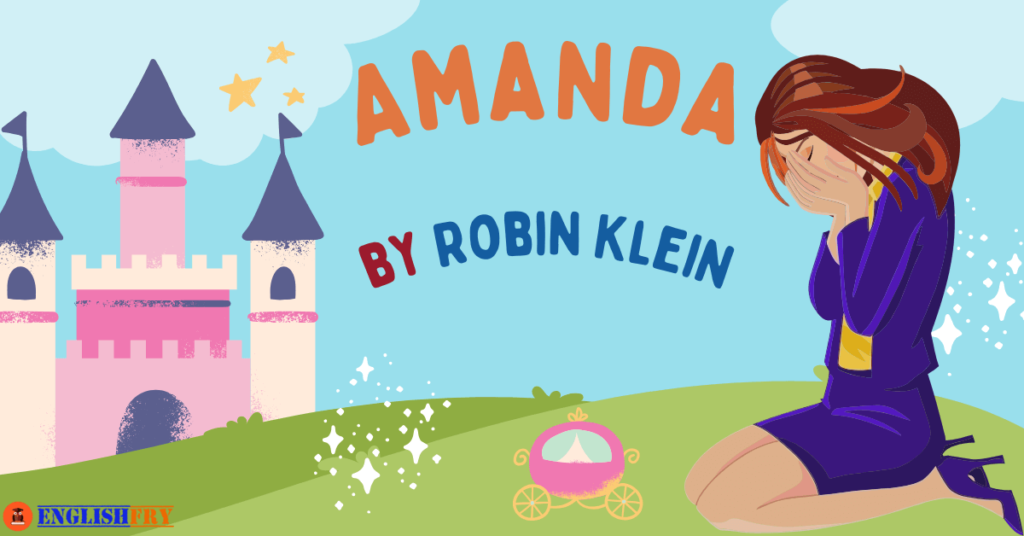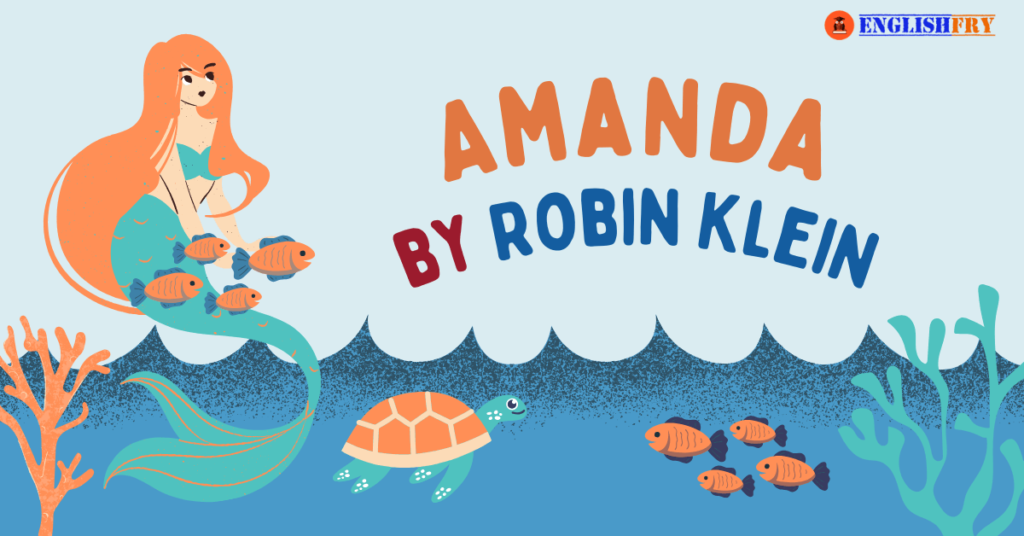Table of Contents
ToggleAbout Poet
Robin Klein was born 28 February 1936 in Kempsey, New South Wales into a family of nine children. Leaving school at age 15, Klein worked several jobs before becoming established as a writer, having her first story published at age 16. She would go on to write more than 40 books, including Hating Alison Ashley (adapted into a feature film starring Delta Goodrem in 2005), Halfway Across the Galaxy and Turn Left (adapted into a television series for the Seven Network in 1992), and Came Back to Show You I Could Fly (adapted into a film directed by Richard Lowenstein in 1993).
Klein’s books are hugely celebrated, having won the CBCA Children’s Book of the Year Award in both the Younger Readers and the Older Readers categories, as well as a Human Rights Award for Literature in 1989 for Came Back to Show You I Could Fly. Klein is widely considered one of Australia’s most prolific and beloved YA authors.

Amanda: Rhyme Scheme
The rhyme scheme of the poem – aaba, ccc, aaba.
Don’t bite your nails, Amanda! – a
Don’t hunch your shoulders, Amanda! – a
Stop that slouching and sit up straight, – b
Amanda! – a
There is a languid, emerald sea, – c
Where the sole inhabitant is me – c
A mermaid, drifting blissfully.) – c
Did you finish your homework, Amanda? – a
Did you tidy your room, Amanda! – a
I thought I told you to clean your shoes! – b
Amanda! – a
Theme of the Poem Amanda
The poem “Amanda” revolves around the themes of control and freedom. These themes are shown through the characters of Amanda, who desires freedom, and the speaker’s mother, who imposes rules and restrictions.
In the poem’s first, third, fifth, and seventh stanzas, the adult exerts control over Amanda. Amanda is told not to bite her nails or slouch. The speaker also asks about her homework and the cleanliness of her room, while forbidding her from eating chocolates. In the final stanza, the adult scolds Amanda for being sulky and moody. This indicates that the speaker is trying to shape Amanda into an ideal, happy, well-behaved, and obedient child. This shows how the speaker is trying to control Amanda’s behavior and daily activities.
Amanda, seeking freedom from this control, turns to daydreams as an escape. These daydreams represent her desire for freedom.

CHARACTERS
The poem provides a brief glimpse into two characters:
- Amanda
- The Speaker (Mother)
Amanda
Amanda is a young girl who drifts in and out of daydreams throughout the poem.
Imaginative: Amanda dreams of being three different figures at different points in the poem. First, she dreams of being a mythical mermaid, then an orphan, and lastly, a fairy-tale princess named Rapunzel. These daydreams indicate that she has a rich imagination.
Desires Peace and Freedom: Amanda’s daydreams symbolise her desire for freedom. The words ‘silence is golden’ and ‘freedom is sweet’ further emphasise Amanda’s desire to be free and lead a peaceful life.
Craves Solitude: As a mermaid, Amanda dreams of being the ‘sole inhabitant’ of the sea. Similarly, as Rapunzel she dreams of living alone in her tower. These daydreams indicate that Amanda craves solitude and wants to be left alone.
Rebellious: One of Amanda’s daydreams involves her being an orphan. By unconsciously wishing her parents dead in this manner, Amanda may be rebelling against their extreme control
The Speaker (Mother)
The unidentified adult speaker in the poem is presumably one of Amanda’s parents.
Controlling: A few examples of the adult’s controlling nature are when they tell Amanda not to bite her nails, hunch her shoulders, and dictate what she eats.
Literary Elements: Amanda
Lorem ipsum dolor sit amet, consectetur adipiscing elit. Ut elit tellus, luctus nec ullamcorper mattis, pulvinar dapibus leo.
A few key literary elements in the poem are:
- Repetition
- Allusion
- Alliteration
- Metaphor
- Anaphora
- Transferred Epithet
- Rhyme Scheme
Repetition
- The name ‘Amanda’ is repeated in the poem to emphasise the restrictions imposed on Amanda by the adult speaker.
- Other repeated words by the adult speaker are ‘don’t’, ‘stop’ and ‘did’ which further emphasise the theme of control.
Allusion
- An allusion is an indirect reference to a person, place, thing, and idea. In the poem, Amanda briefly refers to becoming a ‘mermaid’ and ‘Rapunzel’.
- A mermaid is a sea creature who is half-woman and half-fish and lives in the sea.
- Rapunzel is a character from a fairy-tale.
- Amanda, in the poem, alludes to these figures to stress on her desire to escape from her parents and live a life of freedom.
Alliteration
- The poem contains alliterative words to enhance the rhyme of the poem. In the poem, ‘Stop that slouching and sit up straight’ and ‘stop that sulking’ are examples of alliteration.
Metaphor
- The phrases ‘silence is golden’ and ‘freedom is sweet’ are examples of metaphor. Klein draws an indirect comparison between different things here.
- In ‘silence is golden’, silence is said to be as precious as gold.
- In ‘freedom is sweet’, freedom is said to be like a sweet-tasting fruit.
Anaphora
- Anaphora is a literary device wherein certain words are used at the beginning of successive lines.
- The words ‘don’t bite’ ‘don’t hunch’, ‘did you finish’ and ‘did you tidy’ are examples of anaphora in the poem.
- They further emphasise the nagging and controlling nature of the adult speaker.
Transferred Epithet
- The phrase ‘hushed, bared feet’ is an example of transferred epithet in the poem.
- In the phrase, Amanda’s feet aren’t ‘hushed’ or silent. Rather, the phrase describes the silent way in which Amanda would make dust patterns with her feet as a street orphan.

Question and Answers
1. Question: Who is the speaker in the poem?
Answer: The speaker in the poem addresses Amanda, giving her instructions and advice.
2. Question: What is the rhyme scheme of the poem?
Answer: The rhyme scheme of the poem is AABB. Each stanza consists of two rhyming couplets
3.Question: Who is being addressed as “Amanda” in the poem?
Answer: “Amanda” is the person to whom the speaker is directing their instructions and
4. Question: What is the tone of the poem?
Answer: The tone of the poem can be described as a mix of admonishing, caring, and assertive.
5. Question: What are the instructions given to Amanda in the poem?
Answer: Amanda is instructed not to bite her nails, hunch her shoulders, slouch, eat chocolate, sulk, and to look at the speaker when spoken to.
6.Question: Describe the setting of the first stanza .
Answer: The setting of the first stanza is a peaceful and tranquil emerald sea, where the sole inhabitant is a mermaid, drifting blissfully.
7.Question: What is the speaker’s attitude towards Amanda’s actions?
Answer: The speaker’s attitude towards Amanda’s actions is critical and corrective. They want her to improve her behavior.
8.Question: What is the contrast between the speaker’s world and Amanda’s world in the poem?
Answer: The speaker’s world in the poem is depicted as a serene mermaid in an emerald sea, while Amanda’s world is portrayed as someone who feels like an orphan roaming the streets and having to follow instructions.
9.Question: How does Amanda feel about the instructions given to her?
Answer: The poem doesn’t explicitly mention Amanda’s feelings about the instructions, but she might feel annoyed, nagged or controlled.
10.Question: How does the speaker view life in a tower in the poem?
Answer: The speaker views life in a tower as tranquil and rare, possibly symbolizing a sense of isolation and detachment from the world.
11.Question: How does Amanda’s acne relate to her eating chocolate?
Answer: The poem suggests that eating chocolate might be related to Amanda’s acne, as the speaker reminds her to remember her acne while eating.
12.Question: Describe Amanda’s behavior according to the poem.
Answer: Amanda’s behavior seems to be problematic according to the speaker, as she is biting her nails, slouching, sulking, and not following instructions promptly.
13.Question: What do the actions of the speaker suggest about their relationship with Amanda?
Answer: The actions of the speaker suggest that they have a somewhat controlling or parental relationship with Amanda, being concerned about her behavior and habits.
14.Question: What is the mood of the second stanza of the poem?
Answer: The mood of the second stanza is reflective and peaceful, with the orphan roaming the street in silence and finding freedom in solitude.
15.Question: How does the theme of freedom play a role in the poem?
Answer: The theme of freedom is portrayed through the mermaid and the orphan, both finding freedom in their respective worlds.
16.Question: Identify the poetic devices used in the poem.
Answer: The poem uses
- repetition example- “Don’t,” “Amanda!”
- imagery example-“emerald sea,” “life in a tower”
- allusion example- “Rapunzel”
17.Question: Explain the symbolism of the emerald sea and the mermaid in the poem.
Answer: The emerald sea and the mermaid symbolize a tranquil and blissful existence, possibly representing the desire for a carefree life.
18.Question: How does the poem use fairy tale references to convey its message?
Answer: The poem uses references to fairy tales like Rapunzel to contrast Amanda’s life with idyllic and carefree situations, emphasizing the speaker’s discontent with Amanda’s behavior.
19.Question: Discuss the role of self-expression in Amanda’s life as portrayed in the poem.
Answer: The poem does not explicitly explore Amanda’s self-expression. However, the speaker’s constant instructions may suggest limitations on her ability to express herself freely.
20.Question: How does the poem explore the concept of individuality and conformity?
Answer: The poem indirectly explores individuality by contrasting the speaker’s idealized worlds (mermaid, orphan) with Amanda’s life, suggesting the conflict between being true to oneself and conforming to societal expectations.

MCQ BASED ON NEW NCERT PATTERN
Question 1: What is the main message of the speaker in the poem?
- A) To stop biting nails
- B) To maintain good posture
- C) To complete chores and responsibilities
- D) To pay attention and engage in conversation
Correct Answer: C) To complete chores and responsibilities
Question 2: In the poem, which character or persona does Amanda embody when she’s given advice?
- A) A mermaid
- B) An orphan
- C) Rapunzel
- D) A street performer
Correct Answer: C) Rapunzel
Question 3: How does the poet describe the speaker’s surroundings in the first stanza?
- A) Languid and emerald
- B) Crowded and noisy
- C) Barren and desolate
- D) Tranquil and rare
Correct Answer: A) Languid and emerald
Question 4: What does the speaker warn Amanda against in the poem?
- A) Eating too much chocolate
- B) Neglecting her personal hygiene
- C) Being too moody
- D) Not listening when spoken to
Correct Answer: D) Not listening when spoken to
Question 5: What does the speaker compare Amanda to when giving advice in the poem?
- A) A nagging teacher
- B) Various mythical and imaginative characters
- C) Amanda’s own shortcomings
- D) Amanda’s friends
Correct Answer: B) Various mythical and imaginative characters
Question 6: Which of the following best describes Amanda’s behavior in the poem?
- A) Rebellious
- B) Obedient
- C) Confused
- D) Shy
Correct Answer: A) Rebellious
Question 7: What is the tone of the poem towards Amanda’s actions and behavior?
- A) Encouraging
- B) Critical
- C) Understanding
- D) Indifferent
Correct Answer: B) Critical
Question 8: What type of literary device is used in the line “I am an orphan, roaming the street”?
- A) Metaphor
- B) Simile
- C) Alliteration
- D) Hyperbole
Correct Answer: A) Metaphor
Question 9: In the poem, what do the characters and personas mentioned by the speaker symbolize?
- A) Amanda’s dreams and aspirations
- B) The speaker’s imagination and desires
- C) Amanda’s family members
- D) The external world’s expectations
Correct Answer: B) The speaker’s imagination and desires
Question 10: Which literary device is used in the line “I pattern soft dust with my hushed, bare feet”?
- A) Metaphor
- B) Simile
- C) Personification
- D) Alliteration
Correct Answer: C) Personification
Question 11: What is the common theme in the various personas or characters mentioned in the poem?
- A) Freedom and escape
- B) Homework and responsibilities
- C) Amanda’s emotions and moods
- D) Strict discipline and obedience
Correct Answer: A) Freedom and escape
Question 12: Which character/persona represents tranquility and freedom in the poem?
- A) Amanda
- B) The mermaid
- C) The orphan
- D) Rapunzel
Correct Answer: C) The orphan
Founder of Englishfry.com, a captivating and knowledge-driven blog & Founder of Android app/website Studyfunnel.com, an online Mock Test Series Portal. With a wealth of experience spanning over 16+ years, he has excelled as an Ex-professor, Teacher, Author of Book “Island of Illusion”, Website Developer, Graphic Designer,Blogger,Poet, and Creative academic content writer. His tryst in Literature helped him realize his love for writing and telling stories. A tech-savvy language nerd by day and, a passionate writer by night, he now translates his experiences into tales of wisdom served with a side of humor.His widely recognized profound insights ,captivating writing style makes him contribute to prestigious publications and a sought-after authority in the field.







